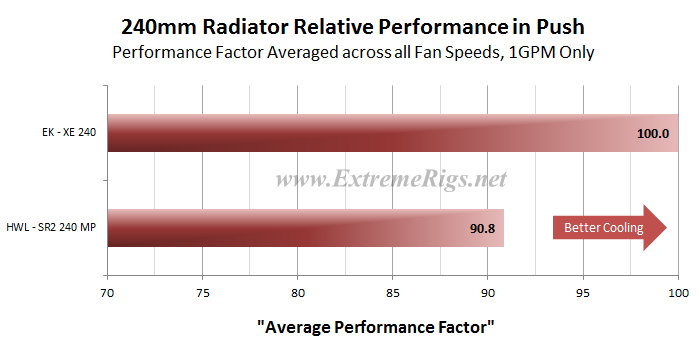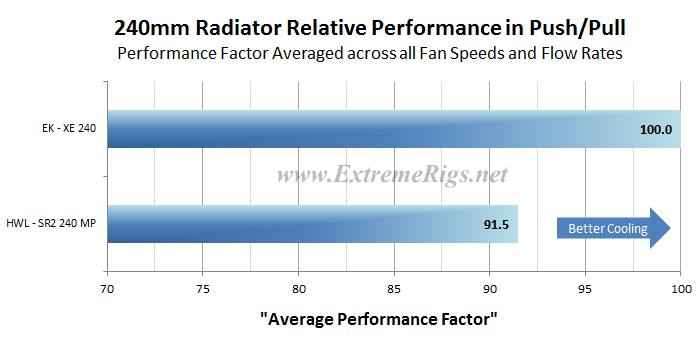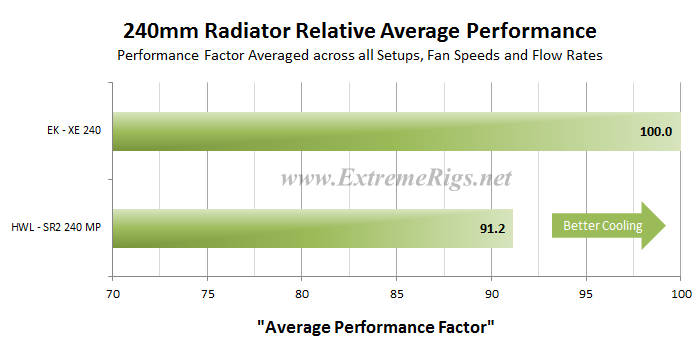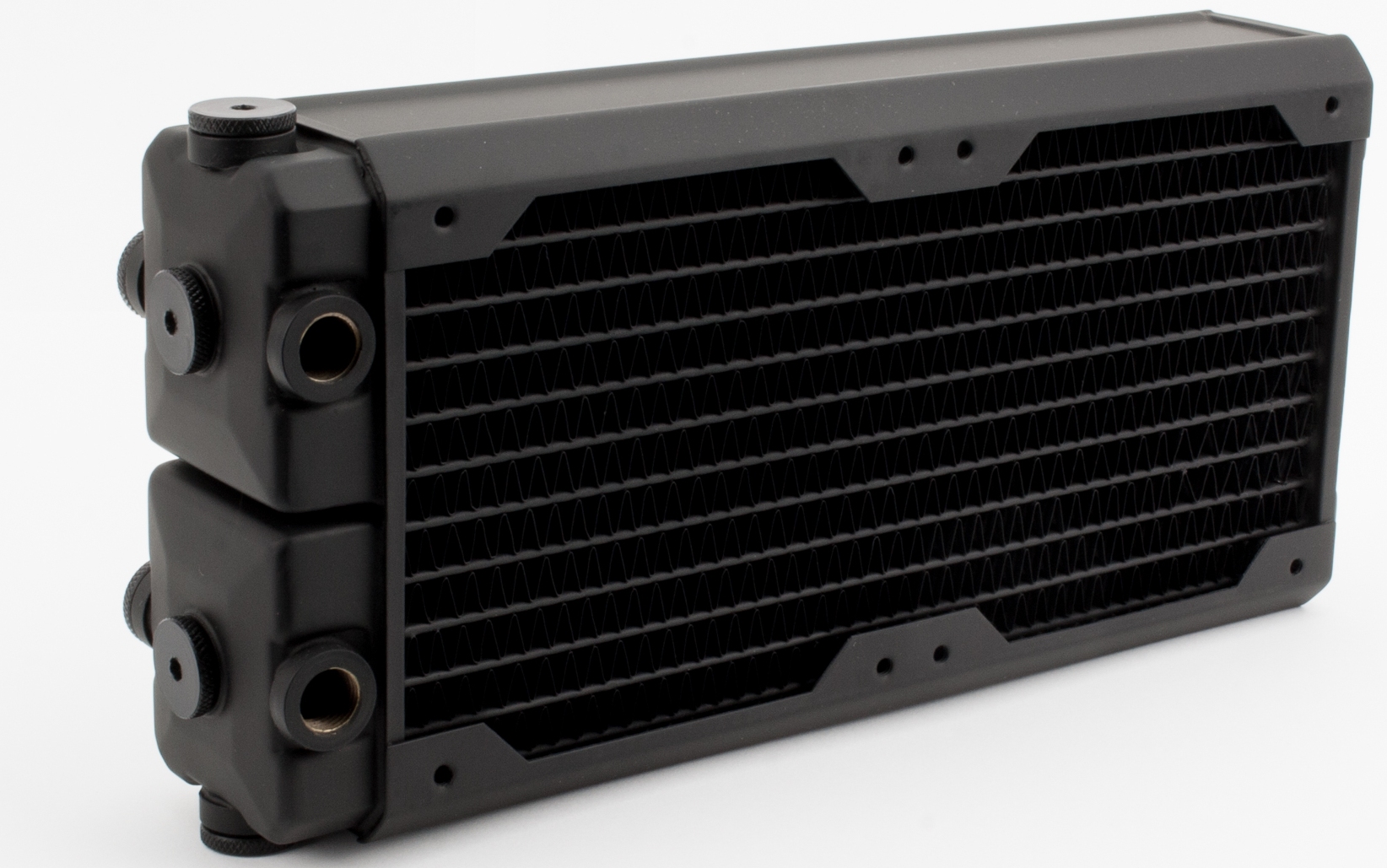This first table shows the SR2 240 MP’s Watts/10 Delta Temp numbers in a quick glance chart format.

Using this data we can effectively show percentage gains/losses relative to a reference point. It’s an interesting way to show gains/losses while changing a variable.
So, let’s focus on 1300 RPM as our reference and see how much gain or loss in performance we get by changing fan speed.

Very even results either side of 1300 rpm indicate that the core is tuned well for low speed fans as we don’t see any major boost in performance as fans speeds are increased.
So from the data above we have a good idea of how the SR2 240 MP radiator performs relative to itself in Push Only and Push/Pull at various fan speed, but there is a large selection of 240mm radiator models to choose from, released from numerous manufacturers.
As we have another 240mm rad with testing complete, let’s compare by putting the SR2 240 head to head with EK’s XE 240. It may not be the fairest comparison ever done because while they are both 60mm thick, the EK XE has a much denser core that should result in much better thermal results. However we’ve been surprised by comparison results before.
Push Only Data vs Competition
Let’s focus on the Push Only results for now and come back to the Push/Pull data later.
Let’s start with 750 RPM and see how it compares to the competition:

Interestingly this is the data point where the SR2 240 MP is most likely to beat the EK rad due to it’s less restrictive core, but being ~6% behind that clearly is not the case. Looking back at the 360 comparisons for these 2 radiators, the SR2 did actually beat the XE at this data point. The different result might be attributed to the higher delta temps of the 240mm tests which the XE may have responded better to. I.E. the 240 radiators used the same 300W heater that the 360 radiators used.
Now let’s look at 1300 rpm:

At 1300 rpm the SR2 falls further behind, now 13% behind the leader.
 At 1850 rpm the SR2 picks up a couple of percentage points, when one might have expected it to fall further behind. I suspect this may be because the SR2’s low FPI is less efficient with higher rpm than the EK’s core. This lower air efficiency resulted in a higher coolant temp, which in turn makes the radiator more efficient.
At 1850 rpm the SR2 picks up a couple of percentage points, when one might have expected it to fall further behind. I suspect this may be because the SR2’s low FPI is less efficient with higher rpm than the EK’s core. This lower air efficiency resulted in a higher coolant temp, which in turn makes the radiator more efficient.
So it appears (as expected given the low PFI count) that the SR2 is well tuned for low fan speeds, but the EK model does still outperform it. Will the SR2 perform similar to other low FPI rads where they perform best in Push Only applications, or can the SR2 hold its own in Push/Pull also?
Let’s find out…
Push/Pull Data vs. Competition
Let’s now look at the Push/Pull results and see how the SR2 compares:
 The SR2 takes second place ~7% behind the XE, and virtually mirrors the Push Only result in terms of the percentage it is behind.
The SR2 takes second place ~7% behind the XE, and virtually mirrors the Push Only result in terms of the percentage it is behind.
Let’s move to 1300 rpm:

In the 1300 rpm Push/Pull category the SR2 240 MP has dropped a few percent and is now 11% behind the XE.
Now 1850RPM:

As with the Push Only result the SR2 regains some ground on the EK rad, but at ~8% behind it is clearly the weaker performer.
Let’s also combine the Push Only and Push/Pull results at our 1.0 GPM flow rate into one plot for each fan speed tested.
Again the 750 rpm first:

Nothing looks out of place here given the data we have reviewed already.
At 1300 rpm everything looks in order given the data we’ve already reviewed. Of interest though is how close the EK rad in Push Only came to beating the SR2 in Push/Pull.
It was exactly the same with the 1850 combined.
 From all of test results we created “Average Performance Factor” charts for both Push and Push/Pull and then a combined plot called the “Master Performance Factor”. The radiator with the best cooling ability (W/10ΔT) at each rpm was awarded a score of 100, and each other radiators W/10ΔT result was scored as percentage of the top performer.
From all of test results we created “Average Performance Factor” charts for both Push and Push/Pull and then a combined plot called the “Master Performance Factor”. The radiator with the best cooling ability (W/10ΔT) at each rpm was awarded a score of 100, and each other radiators W/10ΔT result was scored as percentage of the top performer.
This way of looking at the comparison takes away any advantages that a radiator may have at higher or lower fan speeds and looks at an overall average. While this appears fair it does tend to favor those radiators that are all-rounders and those radiators which do very well at high RPM. Most users should be more focused on their specific use case.
Here is the SR2’s percentage scores at each data point that thermal tests were conducted at with the addition of the SR2’s Push Only results relative to the Best performing Push/Pull results

The percentage numbers in the table offer another way of looking at the SR2’s results comparatively and how it performed, but for our scoring system we need a way to reduce the categories while retaining the data. To do this we average the results for each fan assembly type giving us Averaged Performance Factors for Push Only, Push/Pull and finally an average of everything in the Master Averaged Performance Factor.
Firstly – the Push Only APF:
 The SR2 achieved consistently good results across all fan speeds while not taking out any first places.
The SR2 achieved consistently good results across all fan speeds while not taking out any first places.
Now the Push/Pull APF:
 With a much lower FPI count than the EK XE we didn’t expect miracles from the SR2 in the Push/Pull head to head, but we were surprised that it kept up as well as it did.
With a much lower FPI count than the EK XE we didn’t expect miracles from the SR2 in the Push/Pull head to head, but we were surprised that it kept up as well as it did.
Finally we created the Master Performance Factor which is calculated from the averaged results of all the Push Only and Push/Pull thermal tests, at all fan speeds.

So the SR2 240 MP finishes around 9% behind the XE rad in the performance rankings.
Some of you may be wondering by now why these comparison results differ to the 360mm results where the EK rad was ahead of the SR2 in each category but the results were much closer. The answer to that lies in the way in which we tested the SR2 240 MP, and as stated earlier we tested in the exact same way as we did for the 360mm version to get the comparisons – the key word here being comparisons.
So before we conclude, let’s take a look at those comparisons and see if we can explain the result differences. We did test the 360mm version at 3 flow rates, but only the 1.0 GPM data has been used in the charts below.
 Having done then 360mm testing previously we had to decide how we were going to set up for testing other sizes. There were two practical options, both of which had advantages and disadvantages and none of the ER staff could ever really agree on which was the better option.
Having done then 360mm testing previously we had to decide how we were going to set up for testing other sizes. There were two practical options, both of which had advantages and disadvantages and none of the ER staff could ever really agree on which was the better option.
The first option was to run a power load proportional to that which was run for the 360mm rads, which was 300 Watts. For 240mm rads that would be 200 watts, being 66% of the surface area of a 360mm rad. This would show us the scalability of the different size of each model rad quite well, but the comparison results would be likely to end up in the exact same order as the 360mm Round Up and therefore maybe not the best comparison for readers who may be looking to purchase one or the other size of a particular radiator.
Another problem with this option is that the heater used for testing is 300 Watt, so for larger rads such as 420mm, 480mm and 560mm another heater would need to be incorporated in the test chamber loop, which would be a big change to they system in itself that would likely then render the test system useless for comparisons to older test data (any system change makes things no longer apples to apples – and yes the system is that sensitive).
The second option, which is what we have decided to use, was to run with 300 Watts on the 240 radiators. This mirrors the fact that we keep the heatload constant even when changing fan RPM. This gives a good comparison between different sizes of the same rad, as we are simulating a set load in a similar way to which a running system might. The downside to this test method is that we may run into temperature issues. On the smaller 120mm and 140mm rads 300 Watts is just going to be too much for them to dissipate with safe and acceptable coolant temps, so we may end up not getting full sets of data, in particular the Push Only 750 RPM data point would be almost certain to have coolant temps which are too high to test at. On the other end of the scale for any 480mm or 560mm rads, the cooling potential is likely to be very high resulting in very lower Delta Temps which could lead to data having to be discarded, particularly for the Push/Pull 1850 RPM data point.
There is no right or wrong choice, the results would just be slightly different due to Delta Temps being different between the two test options. In the end we are happy with the option which we chose as we believe is offers the reader a better comparison between different size radiators as they have all been tested under the same conditions. However as a reader you should be aware that W/10DT numbers are not calculated here with a delta of 10C so radiators with higher temperature deltas are operating more efficiently and will score higher than perhaps they should for a true scientific accurate test of heat dissipation for a 10C delta.
Next up – Summary!














Maybe slightly disappointing thermal results, but not a deal breaker. Swarf in rad not a deal breaker either. Flexibility of ports, flexibility of use/fan rpms and overall quality mean that this is still a very good radiator. Again: great test. Now, please get more 240 results!
Often written or said in radiator reviews, “Since the XXX size of brand X radiator has shown XYZ level of performance, one should expect like performance from up-size XXX (or) down size XXX.” If the ratio of/comparable performance of the SR2 240 MP falls short of the SR2 360 MP, should we expect the 480 to provide an additional boost in performance over the 360 or similar performance to the 360? Given what the test results of the 240 tell us, how can an answer to either possibility be justified?
Not sure quite what you’re trying to say Questors – can you explain again?
The 240 performs at about 70% of a 360 when using an equal heatload. However it is running more efficiently as an equal heatload equates to a higher delta T. The 240 *should* of course be 66% of the the 360 and I do believe that it would give us that result if we kept a constant delta T instead of a constant heatload.
So to answer the question – should the 480 provide an additional performance boost over the 360? Absolutely – yes it should. As to how much – we would expect the ideal 33% more cooling ability when measuring a constant delta T, however for a constant heatload you would some efficiency because the delta T would be lower. So to guess – somewhere between 25-30% better cooling.
Does that answer the question?
This was the basis for me asking the question: “However, the thermal Test conditions did not favor the 240mm variant quite as well as the 360mm. The consistency was still there but performance was weaker when compared to the same competitor.”
To me this meant the performance of the SR 240 vs the XE 240 was less proportionate to the SR2 360 results against the XE 360.
Your response clears things up for me – “a constant delta T instead of a constant heatload”
[…] EK XE 240 Radiator Hardware Labs SR2 240 Radiator […]
Comments are closed.